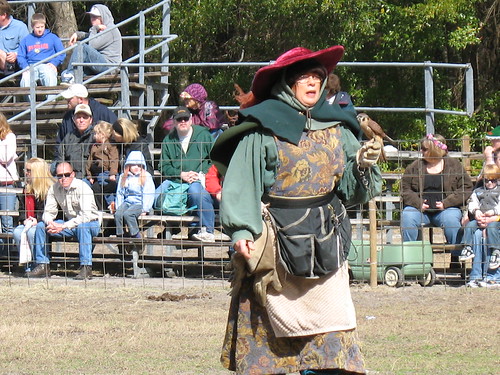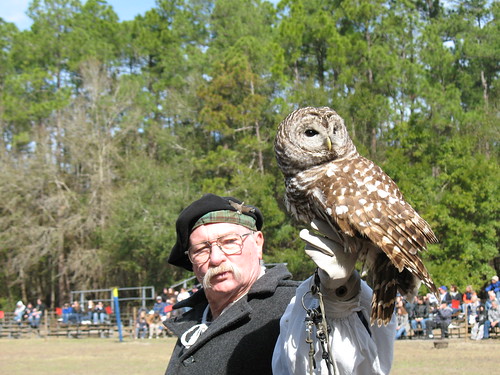The American Kestrel is one of my favorite birds of prey. The are absolutely beautiful, and much smaller than most of the hunting birds. I often see a Kestrel or two perched on power lines that run over a large farm field on my way to Adams Tract. The gentleman is holding the brightly colored male and the woman is holding the female Kestrel.


The Barn Owl is a stunning and fascinating bird as well. A Barn Owl is a very fun bird to teach people about because of all of its interesting qualities. For instance, its uniquly shaped face works as a sound receptor and its ears are uneven (one is higher than the other) so that they can better pinpoint the exact direction that a sound is coming from. They hunt at night, so sound is much more useful than vision. Their feathers have soft edges that allow the owls to fly through the air silently to catch their prey. They also eat a great deal of mice. Its works out well for farmers that Barn Owls do frequent barns. One Barn Owl can eat two or three mice each night. What barn cat can do that? Barn Owls also give us a great opportunity to see what they have been eating. Near their roosting sight, Barn Owls leave pellets. The pellets are the bits of their food that are indigestible. If an owl eats a mouse, the bones, teeth, and hair can't be digested by the owl, so they are compacted into a pellet and regurgitated. These pellets can be dissected and the bones can be pieced together to find what an owl has eaten. It may sound gross, but all of the gross "guts" and "yuck" have been digested, they are dry, compact blobs of fur and bones. If it sounds like fun, I found a web page that will simulate the experience for you. Sterilized owl pellets can also be ordered online for classes or educational groups. I found a pellet once when I was working at a nature center in Delaware. I brought the pellet home and my oldest nephew and I had fun trying to figure out what mouse bones went where. Its like being a miniature archaeologist unearthing the tiniest dinosaur ever! This owl was freed from his carrier and immediately flew to his trainer for a treat. It was very impressive.


The Barred Owl is the most common owl at Troy Springs. I see them often and have blogged about them before. Their faces seem very expressive to me. If I remember correctly, this particular bird was found injured on the side of the road. It was injured too badly to have a normal life in the wild so now it is an educational aide.

1 comment:
How very interesting to learn the tidbit about the owl pellets. Now I will have to do some searching to see if I can run across some near my home. I do hear the owls in the evening, so know they hunt in my neighborhood.
Post a Comment